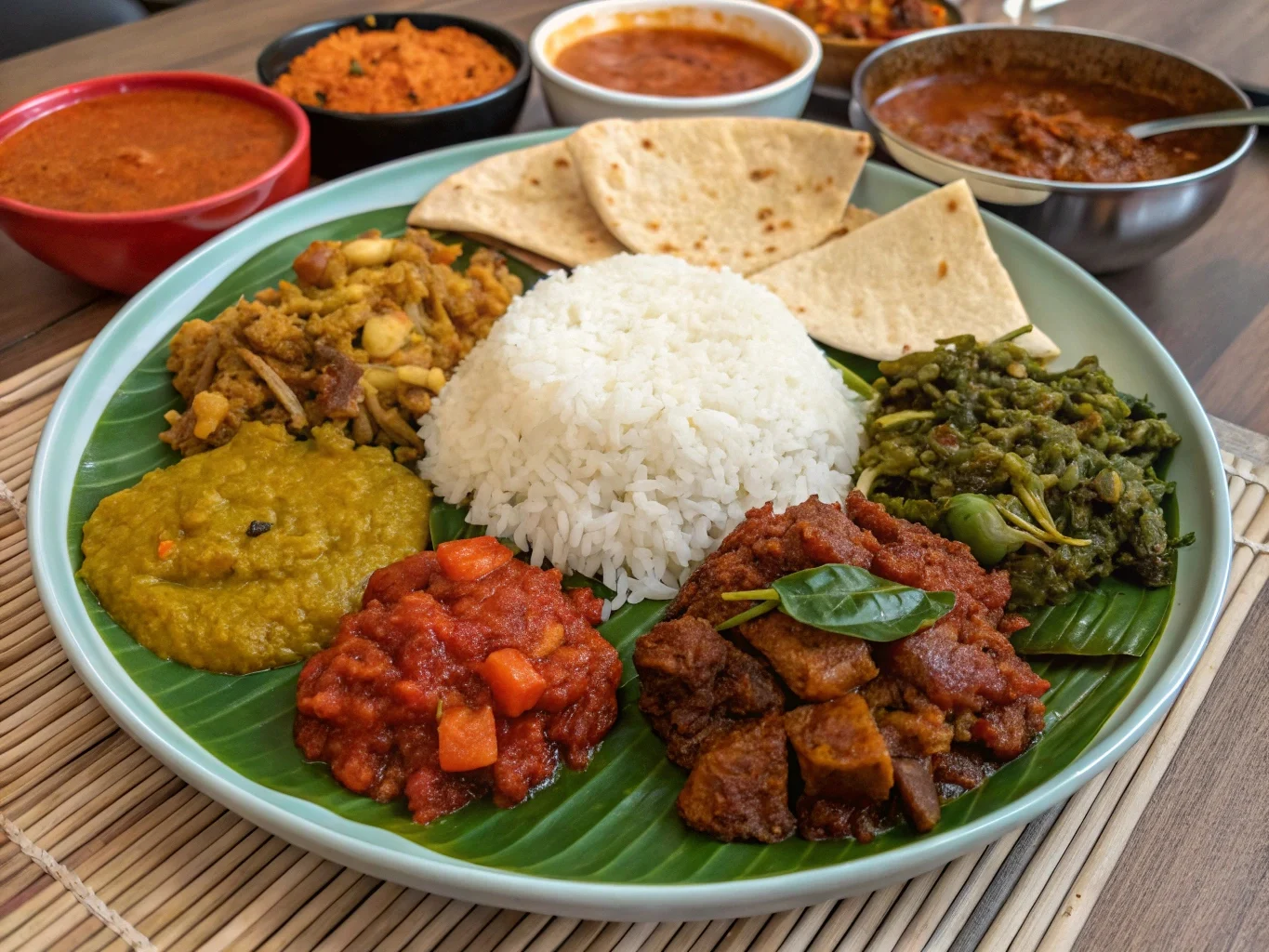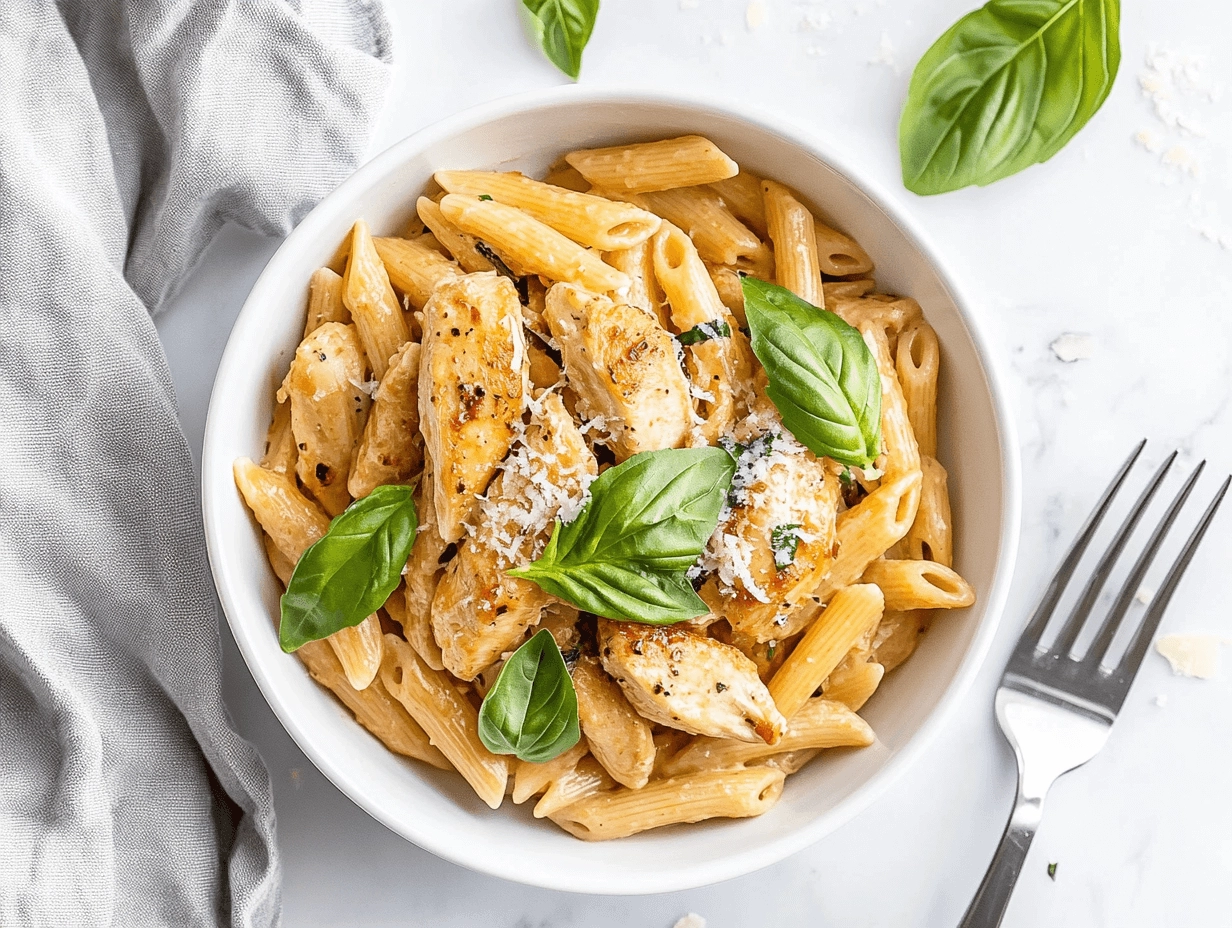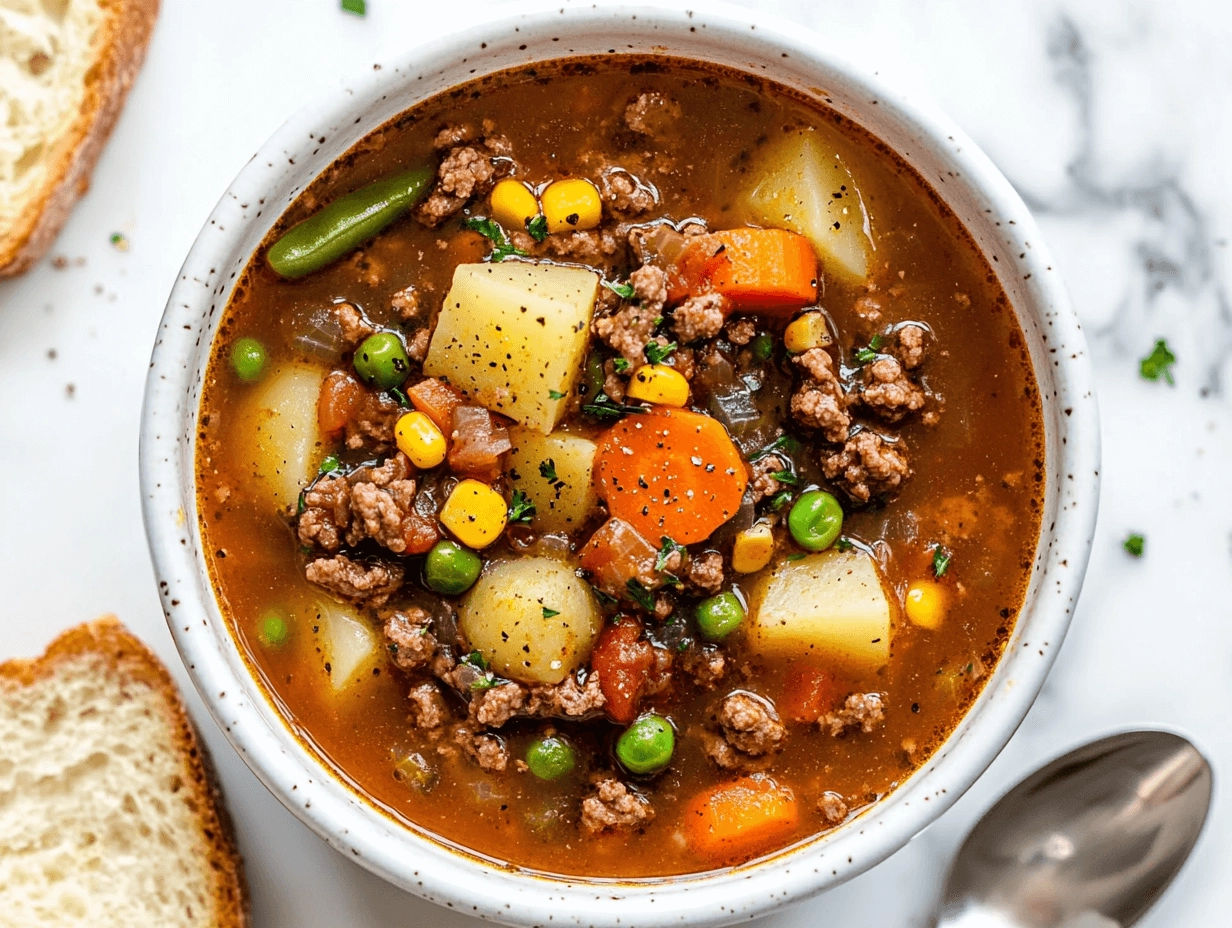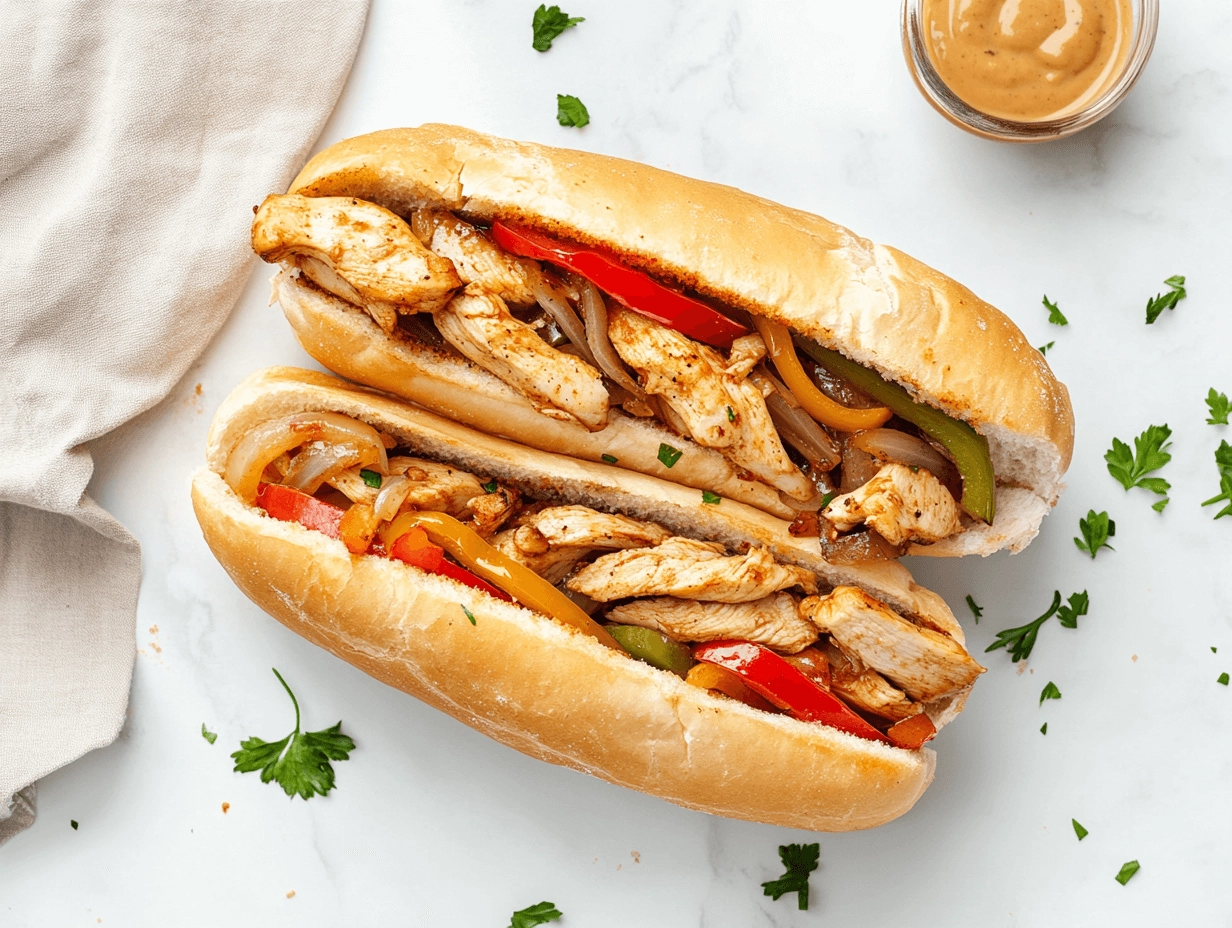Sri Lankan cuisine is an explosion of bold flavors, vibrant colors, and aromatic spices. A traditional Sri Lankan lunch is a well-balanced meal that combines rice, curries, sambols, and condiments, creating a feast that is both hearty and delicious.
Each dish tells a story of Sri Lanka’s rich history and diverse cultural influences. The use of coconut, fragrant spices, and tropical ingredients sets Sri Lankan food apart from other South Asian cuisines. Whether you are new to Sri Lankan cooking or looking to perfect your favorite recipes, this guide will walk you through every essential detail.
Expect to explore traditional rice and curry pairings, must-have side dishes, and expert cooking tips to create a truly authentic Sri Lankan lunch experience at home.
Table of Contents
Discover more delicious recipes and ideas by visiting our homepage!
Essential Ingredients in Sri Lankan Cuisine
Sri Lankan food relies on a few key ingredients that define its unique flavor profile. Understanding these staples will make it easier to recreate authentic Sri Lankan lunch recipes at home.
Rice and Grains: The Heart of Every Meal
Rice is more than just a side dish in Sri Lanka—it is the foundation of every meal. Different varieties bring unique textures and flavors:
- Red Samba Rice – This unpolished rice has a nutty taste and a slightly chewy texture, making it a great choice for traditional Sri Lankan meals.
- Basmati Rice – A fragrant and light option, often served with festive curries.
- Kiribath (Milk Rice) – A coconut-infused rice dish served on special occasions, perfect for a comforting meal.
Rice is always paired with an assortment of curries, sambols, and side dishes, ensuring a harmonious balance of flavors.
Spices and Aromatics: The Soul of Sri Lankan Cooking
Sri Lankan cuisine is known for its rich spice blends and bold aromatics. The secret to authentic flavors lies in these essentials:
- Curry Leaves & Pandan Leaves – These add a deep, earthy aroma to most dishes.
- Cinnamon, Cloves, & Cardamom – Used in both sweet and savory dishes, these spices define Sri Lankan curries.
- Turmeric, Mustard Seeds, & Cumin – Provide warmth and depth to various curries.
- Dried Red Chilies & Black Pepper – Add the characteristic heat that makes Sri Lankan food unique.
Freshly ground spice blends, often roasted before use, create the signature taste that makes Sri Lankan curries unforgettable.
Coconut in Sri Lankan Cuisine
Coconut is the most versatile ingredient in Sri Lankan cooking. It appears in almost every meal, contributing richness and depth to dishes:
- Coconut Milk – Used in curries, making them creamy and flavorful.
- Grated Coconut – A key ingredient in sambols, adding texture and subtle sweetness.
- Coconut Oil – Preferred for frying and tempering spices, lending a unique aroma to dishes.
The abundant use of coconut ensures that Sri Lankan food is both nutritious and deeply satisfying.
Proteins: A Balance of Meat, Fish, and Plant-Based Options
Sri Lankan cuisine includes a diverse range of protein sources, making it easy to customize meals based on dietary preferences.
- Fish & Seafood – Sri Lanka’s coastal location makes seafood a staple. Dishes like Fish Ambul Thiyal (Sour Fish Curry) showcase its importance.
- Chicken & Mutton – Slow-cooked in fragrant spice blends, these meats form the heart of many traditional curries.
- Dhal (Lentils) & Jackfruit – Essential plant-based proteins that are both flavorful and nutritious.
Tip: Looking for a lighter, vegetable-packed option? Try pairing your meal with a fresh Sri Lankan salad recipe for a well-balanced and refreshing side dish.
Traditional Sri Lankan Lunch Recipes
Rice and Curry: The Ultimate sri lankan lunch recipes
A traditional Sri Lankan lunch features a perfectly balanced combination of flavors, textures, and colors. A standard meal includes:
- Steamed or tempered rice as the base.
- A main curry, such as chicken, fish, or dhal curry.
- One or two vegetable curries, like brinjal moju or pumpkin curry.
- Sambols & condiments, including pol sambol and lunu miris, to add depth and spice.
The layering of flavors is what makes Sri Lankan cuisine so unique and exciting.
Popular Sri Lankan Curries
Sri Lankan Chicken Curry (Kukul Mas Curry)
This deeply aromatic chicken curry is a favorite across the country. It’s made with:
- Coconut milk for a rich base
- Roasted curry powder for depth
- Fresh curry leaves for a bold aroma
The result is a flavor-packed dish that pairs beautifully with rice.
Dhal Curry (Parippu Curry)
A staple of Sri Lankan cuisine, dhal curry is both comforting and nutritious. It’s slow-cooked with:
- Coconut milk for a creamy texture
- Mustard seeds and fresh turmeric for warmth
- Dried red chilies for a gentle heat
This curry is the perfect complement to spicy meat dishes.
Eggplant Moju (Brinjal Pickle)
This sweet, sour, and spicy eggplant dish is an essential addition to any Sri Lankan meal. The eggplant is deep-fried until crispy and then tossed with:
- Vinegar for acidity
- Mustard seeds for pungency
- Chili flakes for a fiery kick
It’s a flavor explosion that brings contrast and complexity to the plate.
Short Eats: Traditional Sri Lankan Lunch Snacks
Sri Lanka’s short eats are perfect for a light meal or afternoon snack. These include:
- Fish Cutlets – Crispy, golden-brown croquettes with a spicy filling.
- Vegetable Roti – A flaky flatbread stuffed with a curried vegetable mixture.
- Egg Hoppers & String Hoppers – Served with spicy sambols for extra flavor.
These savory snacks add variety and texture to a Sri Lankan lunch spread.
Fresh Salads & Side Dishes
Gotu Kola Sambol
A nutritious herbal salad made with:
- Finely chopped gotu kola leaves
- Grated coconut for sweetness
- A squeeze of lime for a citrusy contrast
This dish adds freshness and balance to the meal.
Cucumber & Onion Raita
A cooling yogurt-based salad, perfect for counteracting spicy curries.
Sri Lankan Mango Chutney
A sweet, tangy, and spicy mango relish that complements rice and curries beautifully.
Cooking Instructions & Meal Preparation Guide
How to Cook a Traditional sri lankan lunch recipes
| Ingredient | Amount | Notes |
|---|---|---|
| Rice (Samba/Basmati) | 2 cups | Soak for 30 minutes before cooking |
| Chicken (or fish) | 500g | Cut into pieces |
| Dhal (Red Lentils) | 1 cup | Washed and drained |
| Coconut Milk | 1 cup | Fresh or canned |
| Curry Leaves | A handful | Essential for authentic flavor |
| Chili Powder | 1 tsp | Adjust to taste |
At this point, we’ve explored the essential ingredients, staple curries, and meal preparation guide for an authentic sri lankan lunch recipes. The second half of this article will dive into cooking techniques, expert tips, and FAQs to enhance your Sri Lankan cooking skills.
Stay tuned for expert tips on achieving the perfect flavors and answers to common Sri Lankan cuisine questions! 🚀
Cooking Techniques & Expert Tips for Perfect Sri Lankan Lunch Recipes
A great Sri Lankan lunch isn’t just about following recipes—it’s about mastering the techniques that bring out the best flavors. From the way spices are roasted to how curries are simmered, every step matters.
Mastering the Art of Spice Roasting
Roasting spices correctly enhances their natural flavors and deepens the taste of curries. Here’s how to do it:
- Use a dry pan – Heat a skillet over medium heat with no oil.
- Add whole spices first – Toss in cinnamon sticks, cloves, and cardamom pods. Stir continuously.
- Add powdered spices last – Ground coriander, cumin, and curry powder burn quickly, so add them just before removing the pan from the heat.
- Cool before grinding – Let the spices cool before grinding them into a fine powder.
Tip: Roasted curry powder is a signature element of Sri Lankan cuisine. You can store it in an airtight container for up to a month without losing its aroma.
The Right Way to Cook Rice for Sri Lankan Meals
Perfectly cooked Sri Lankan rice should be fluffy, aromatic, and slightly firm. Here’s the best method:
- Rinse the rice thoroughly – Washing the rice at least three times removes excess starch and prevents stickiness.
- Use the correct water ratio – For red samba rice, use 1 part rice to 2.5 parts water. For basmati rice, a 1:2 ratio works best.
- Add pandan and curry leaves – These natural flavor enhancers make a huge difference in aroma.
- Cover and let steam – Once cooked, let the rice rest for 5 minutes before fluffing with a fork.
How to Make an Authentic sri lankan lunch recipes Step-by-Step
Creating a full Sri Lankan lunch spread requires proper planning. Below is a breakdown of how to prepare each element efficiently.
Step 1: Start with the Main Curry
Sri Lankan curries require slow cooking to build depth. Whether using chicken, fish, or vegetables, the base remains the same:
- Heat coconut oil and temper mustard seeds, curry leaves, and onions.
- Add garlic, ginger, and green chilies for fragrance.
- Mix in spice blends (turmeric, cumin, roasted curry powder).
- Pour in coconut milk and let the curry simmer for at least 20-30 minutes for full flavor development.
Step 2: Prepare the Vegetable Side Dishes
A well-balanced sri lankan lunch recipes includes at least two vegetable curries. Popular options include:
- Pumpkin Curry: Creamy and slightly sweet, made with coconut milk.
- Beetroot Curry: Adds color and earthy sweetness to the plate.
- Green Bean Stir-Fry: A light, garlicky dish that complements spicy flavors.
Tip: Cooking vegetables with minimal water helps retain their nutrients and vibrant colors.
Step 3: Make a Spicy Sambol
Sambols are essential condiments that add heat and texture. The two most common types are:
- Pol Sambol: Grated coconut, chili flakes, lime juice, and salt.
- Lunu Miris: A fiery blend of onions, chili powder, and Maldive fish.
For the best flavor, use a stone mortar and pestle instead of a blender.
Looking for a protein-packed lunch? Check out these rotisserie chicken lunch recipes for more ideas.
Step 4: Assemble the Meal and Serve
A proper Sri Lankan lunch spread is served in separate bowls, allowing diners to mix flavors as they eat. The final plate should have:
- A generous portion of rice
- One protein-rich curry (chicken, fish, or dhal)
- Two vegetable curries for variety
- A side of sambol for heat
- Papadam or pickles for crunch and acidity
Pro Tips & Variations
For a truly authentic Sri Lankan meal, try these expert tips:
1. Balancing Heat Levels
Sri Lankan food can be intensely spicy, but you can adjust the heat:
- Use coconut milk to tone down spice.
- Add sugar to balance overly spicy dishes.
- Serve cucumber raita to cool the palate.
2. Enhancing Flavor with Homemade Spice Mixes
Store-bought curry powder works, but homemade blends make a big difference. Roast and grind your own spices for a fresher, more intense taste.
3. Meal Prep & Storage Tips
- Curries taste better the next day as the flavors deepen overnight.
- Sambols should be eaten fresh to maintain texture.
- Cooked rice lasts up to 3 days in the fridge.
FAQs About Sri Lankan Lunch Recipes
What do Sri Lankan people eat for lunch?
sri lankan lunch recipes are centered around rice and multiple curries, usually served with sambols and pickles. A balanced plate includes:
A main protein curry (chicken, fish, or dhal)
Two vegetable-based curries
Coconut-based sambols
Papadam or chutneys for texture and acidity
For those interested in cooking, Sri Lankan lunch recipes often feature rice as the base, accompanied by flavorful curries and condiments.
What is a traditional Sri Lankan meal?

A traditional Sri Lankan meal consists of a variety of dishes designed to offer a balance of flavors—spicy, sweet, tangy, and savory—all served with rice, often inspired by authentic Sri Lankan lunch recipes.
What do Sri Lankans eat the most?
Rice is the most consumed staple, accompanied by coconut-based curries and spicy condiments like pol sambol and lunu miris, all key elements in Sri Lankan lunch recipes.
What are traditional Sri Lankan short eats?
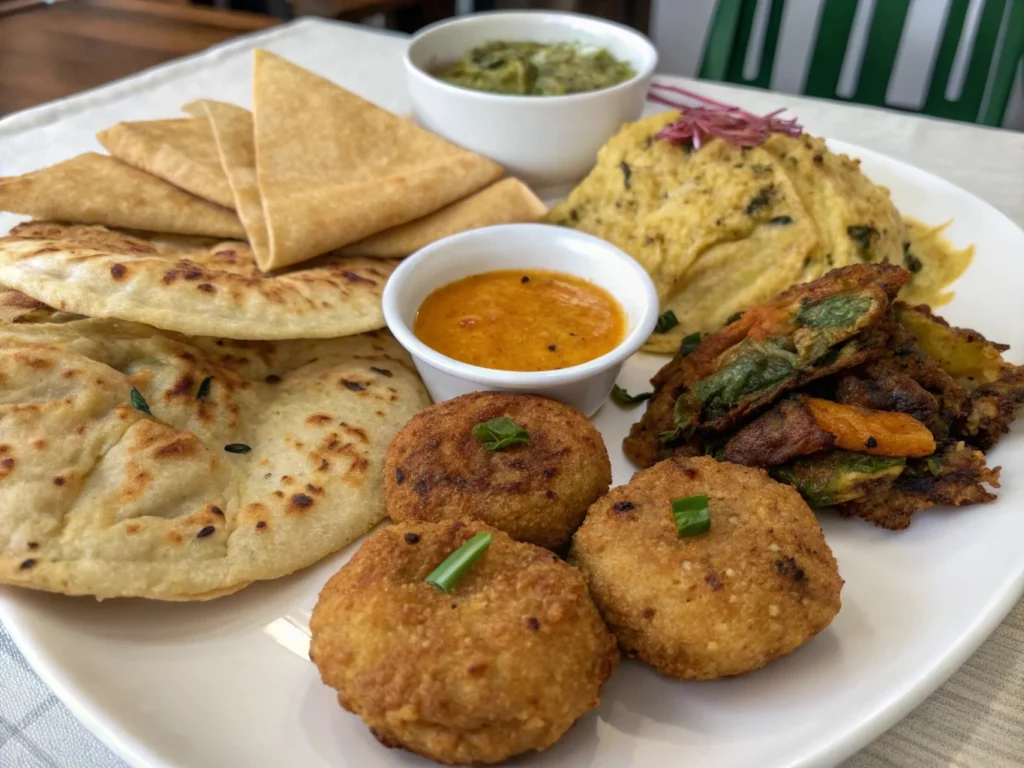
Short eats are savory snacks that can be enjoyed for lunch or tea time, such as:
Fish Cutlets – Spicy, deep-fried fish croquettes.
Vegetable Roti – Thin, stuffed flatbreads.
Ulundu Vadai – Crunchy lentil fritters, popular in Sri Lankan lunch recipes.
Is salad okay to eat in Sri Lanka?
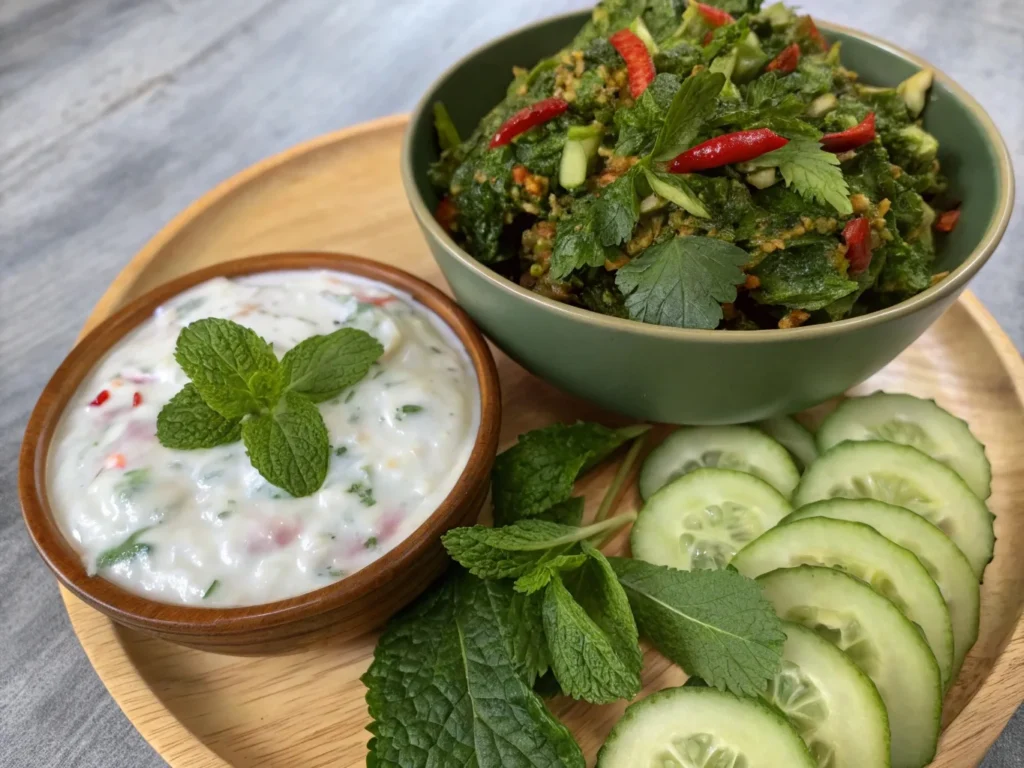
Yes! Fresh salads like Gotu Kola Sambol and cucumber raita are common and help balance spicy curries, often included in Sri Lankan lunch recipes.
Is Sri Lankan food similar to Indian food?
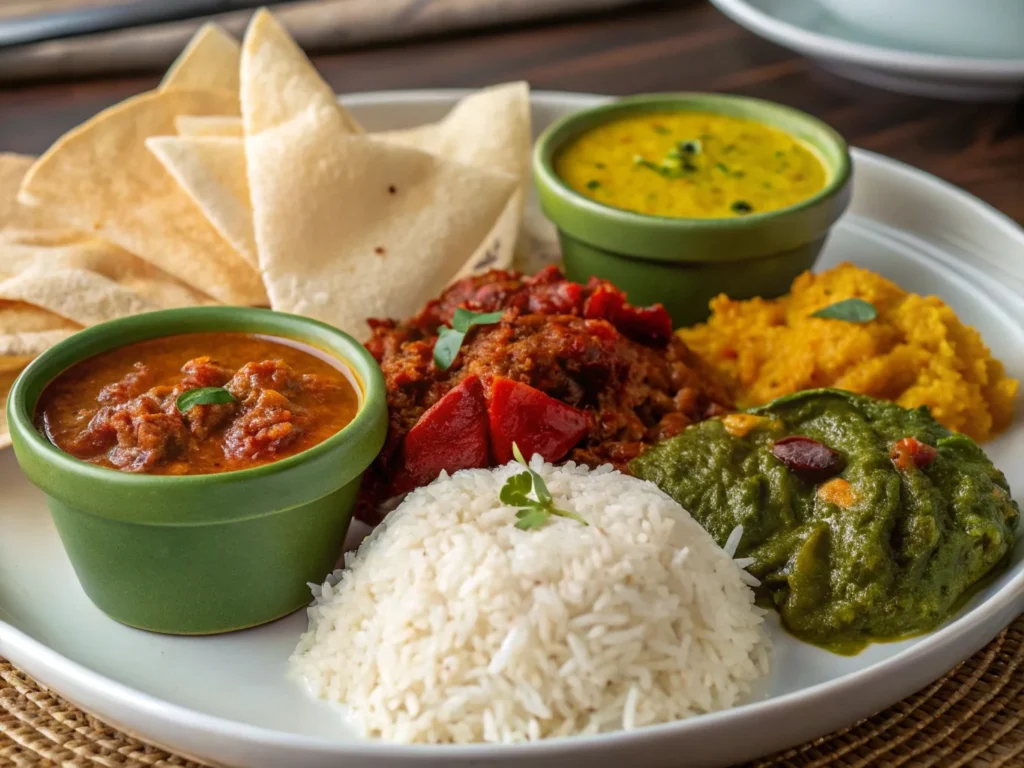
While they share some similarities, Sri Lankan cuisine is distinct because of its unique spice blends, coconut-based curries, and seafood-heavy dishes, setting it apart from Indian cuisine in Sri Lankan lunch recipes.
PrintTraditional Sri Lankan Rice & Curry Lunch
- Total Time: 1 hour 15 minutes
- Yield: A complete Sri Lankan lunch plate
Description
A traditional Sri Lankan lunch is a vibrant, flavorful, and well-balanced meal featuring steamed rice, an aromatic curry, spiced vegetable sides, and fiery sambols. This meal embodies the perfect blend of coconut-infused richness, bold spices, and fresh tropical ingredients. Whether you’re new to Sri Lankan cuisine or looking to perfect your cooking skills, this authentic rice and curry spread will transport you straight to the heart of Sri Lanka.
Ingredients
For the Rice:
- 2 cups Samba rice (or Basmati)
- 5 cups water
- 1 sprig curry leaves
- 1 small piece pandan leaf (optional)
- ½ tsp salt
For the Sri Lankan Chicken Curry (Kukul Mas Curry):
- 500g chicken, cut into pieces
- 1 large onion, sliced
- 3 cloves garlic, minced
- 1-inch piece ginger, grated
- 2 sprigs curry leaves
- 1 small piece pandan leaf (optional)
- 1 tbsp coconut oil
- 1 tsp mustard seeds
- 2 tsp Sri Lankan roasted curry powder
- 1 tsp turmeric powder
- 1 tsp chili powder (adjust to taste)
- ½ tsp black pepper powder
- 1 cup thick coconut milk
- 1 cup thin coconut milk or water
- 1 tsp salt, or to taste
- 1 tsp lime juice (optional)
For the Dhal Curry (Parippu Curry):
- 1 cup red lentils (masoor dhal)
- 1 small onion, chopped
- 2 cloves garlic, minced
- 1 tsp turmeric powder
- ½ tsp mustard seeds
- 2 sprigs curry leaves
- 1 small piece pandan leaf (optional)
- ½ cup thick coconut milk
- 1½ cups water
- ½ tsp salt, or to taste
For the Brinjal Moju (Eggplant Pickle):
- 2 large eggplants, sliced into thin strips
- 1 tbsp vinegar
- 1 tsp sugar
- 1 tsp mustard seeds
- ½ tsp chili flakes
- ½ tsp salt
- 2 tbsp coconut oil (for frying)
For the Pol Sambol (Coconut Sambol):
- 1 cup grated coconut (fresh or frozen)
- 1 small red onion, finely chopped
- 1 tsp chili flakes (adjust to taste)
- ½ tsp salt
- 1 tsp lime juice
- 1 tsp Maldive fish flakes (optional)
Instructions
Step 1: Cook the Rice
- Rinse the rice thoroughly and soak for 20-30 minutes.
- In a pot, bring 5 cups of water to a boil. Add the rice, curry leaves, pandan leaf, and salt.
- Reduce the heat to low, cover, and cook until the water is absorbed and rice is tender.
- Fluff with a fork and keep warm.
Step 2: Prepare the Chicken Curry
- Heat coconut oil in a pot and add mustard seeds. When they start popping, add onions, garlic, ginger, curry leaves, and pandan leaf.
- Sauté until onions turn golden brown.
- Add the chicken, followed by roasted curry powder, turmeric, chili powder, and black pepper.
- Stir well and cook for 5 minutes until the chicken is browned.
- Pour in thin coconut milk (or water) and simmer for 20 minutes.
- Add thick coconut milk and simmer for another 10 minutes until the curry thickens.
- Adjust salt and finish with a squeeze of lime juice.
Step 3: Cook the Dhal Curry
- Rinse the red lentils and drain.
- In a pot, combine lentils, water, onions, garlic, turmeric, curry leaves, and pandan leaf.
- Bring to a boil, then reduce heat and simmer for 15-20 minutes until soft.
- In a separate pan, heat oil and temper mustard seeds.
- Pour over the dhal, add thick coconut milk, and simmer for 5 more minutes.
Step 4: Make the Eggplant Moju
- Deep-fry the eggplant slices until golden brown and crispy. Drain on paper towels.
- Heat oil in a pan and add mustard seeds, followed by vinegar, sugar, chili flakes, and salt.
- Toss in the fried eggplant and mix well.
Step 5: Prepare the Pol Sambol
- In a bowl, mix grated coconut, red onion, chili flakes, salt, lime juice, and Maldive fish (if using).
- Using your fingers or a spoon, mix and slightly crush the ingredients to release flavors.
Step 6: Assemble and Serve
- Place a generous scoop of rice in the center of a plate.
- Ladle chicken curry over one side.
- Spoon dhal curry on the other side.
- Add a portion of brinjal moju and a scoop of pol sambol.
- Serve with papadam and a fresh cucumber salad for a full meal.
Notes
- For a vegetarian version, replace chicken with jackfruit or soy protein.
- Adjust spice levels by adding or reducing chili powder and flakes.
- Leftover curries taste better the next day as the flavors develop overnight.
- Best served fresh but can be stored in airtight containers in the refrigerator for up to 3 days.
Enjoy this delicious Sri Lankan rice and curry meal, a true explosion of flavors and culture on a plate! 🍛🔥
- Prep Time: 30 minutes
- Cook Time: 45 minutes
- Category: Lunch
- Cuisine: Sri Lankan
Nutrition
- Serving Size: 4 servings
- Calories: ~550 kcal
- Fat: ~25g
- Carbohydrates: ~60g
- Fiber: ~10g
- Protein: ~30g
Conclusion
Sri Lankan lunch recipes showcase a beautiful balance of spices, textures, and flavors, making them one of the most exciting and flavorful cuisines in the world. Whether you’re making a classic rice and curry spread or experimenting with spicy sambols and short eats, the key lies in using fresh ingredients and mastering traditional techniques.
Now that you have a full guide, it’s time to bring Sri Lankan flavors into your kitchen and enjoy the authentic experience of a home-cooked Sri Lankan meal.

